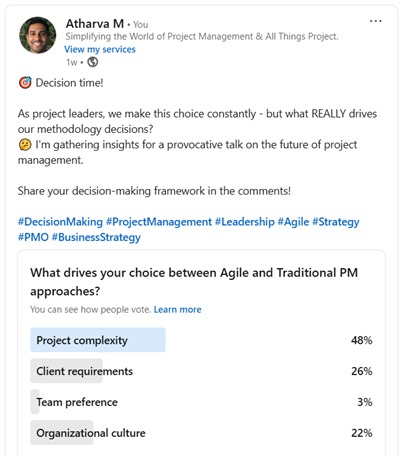Project management is not a one-size-fits-all approach. The choice between Agile and Traditional (Waterfall) methodologies is a crucial decision that can significantly impact project success. But what truly drives these choices? To uncover industry trends, we conducted a poll asking professionals: What drives your choice between Agile and Traditional PM approaches?

The Poll Results: The responses shed light on the key decision-making factors:
- Project Complexity (48%) – The leading factor influencing the choice of methodology.
- Client Requirements (26%) – Aligning with client expectations plays a significant role.
- Organizational Culture (22%) – The company’s internal working style impacts the methodology selection.
- Team Preference (3%) – Surprisingly, team preference had the least impact.
Deep Dive into the Decision-Making Factors:

- Project Complexity: The Driving Force (48%)
Complex projects with evolving requirements, multiple dependencies, and high uncertainty often demand Agile’s flexibility. Traditional methodologies, however, work well for structured, predictable projects with clear timelines. Industry leaders recognize that as complexity grows, so does the need for adaptability, making Agile the preferred choice for dynamic environments.
To illustrate, software development projects with continuous user feedback loops are best handled with Agile. Meanwhile, large-scale construction projects, where upfront planning is crucial, are better suited for Traditional PM approaches.
Additionally, businesses facing regulatory constraints may lean towards Traditional methodologies, ensuring compliance at every phase. Conversely, startups launching innovative products often favor Agile to pivot quickly based on market feedback.
- Client Requirements: The Balancing Act (26%)
Many organizations must align their approach with client expectations. If a client demands detailed upfront planning, a Traditional methodology might be chosen. On the other hand, Agile is often preferred when clients seek iterative improvements and continuous feedback. Balancing the methodology with client needs is a strategic decision for project managers.
For example, in industries like finance and healthcare, where compliance and security are top priorities, clients might demand structured processes with predefined milestones. In contrast, IT firms developing SaaS products may prefer Agile due to the iterative nature of software releases.
- Organizational Culture: Adaptability vs. Structure (22%)
A company’s internal culture heavily influences methodology selection. Organizations that prioritize innovation and adaptability often gravitate towards Agile, while those with rigid hierarchies and structured workflows may find Traditional approaches more suitable. Leaders must assess whether their culture supports iterative development or requires a more phased approach.
A good example is how tech giants like Google and Spotify champion Agile methodologies to foster innovation, while manufacturing firms often stick to Traditional PM frameworks to maintain consistency and efficiency.
A strong organizational culture that embraces change allows for Agile adoption, enabling cross-functional teams to work collaboratively and iteratively. However, businesses operating in traditional sectors may require a more structured approach, ensuring alignment with long-term business objectives.
- Team Preference: A Surprising Insight (3%)
Interestingly, team preference ranked lowest in decision-making. While team buy-in is essential for project success, broader business and project considerations often take precedence. This finding suggests that while methodologies impact teams, external and organizational factors drive decisions more strongly.
However, this doesn’t mean team dynamics should be ignored. A well-trained team that understands Agile principles can drive successful implementations. On the flip side, resistance to Agile in a traditionally structured organization can hinder progress.
Key Takeaways for Project Managers:
- Assess complexity – If your project involves frequent changes, Agile is likely the better choice.
- Align with stakeholders – Understanding client expectations is critical in methodology selection.
- Consider company culture – The working environment should support the chosen approach.
- Educate and empower teams – While team preference is lower in priority, ensuring they understand and can adapt to the methodology is essential.
The Future of Project Management:
As industries evolve, project management methodologies will continue to adapt. With the rise of hybrid models combining Agile and Traditional approaches, organizations are finding innovative ways to balance structure with flexibility.
For instance, many large enterprises are now implementing Scaled Agile Framework (SAFe) to manage large-scale Agile projects while maintaining governance and compliance. Similarly, industries like construction are integrating Agile principles into their workflows, enabling faster decision-making and improved collaboration.
Moreover, AI and automation are playing a pivotal role in project management, helping teams analyze project complexity, predict risks, and optimize workflows. The increasing reliance on digital tools is shaping how methodologies are applied, making adaptability even more crucial.
Final Thoughts:
The debate between Agile and Traditional methodologies continues, but data suggests that complexity is the key determinant. As organizations evolve, project managers must remain adaptable, evaluating each project’s unique demands before making methodology decisions.
What factors drive your project methodology choices? Let’s discuss in the comments!


